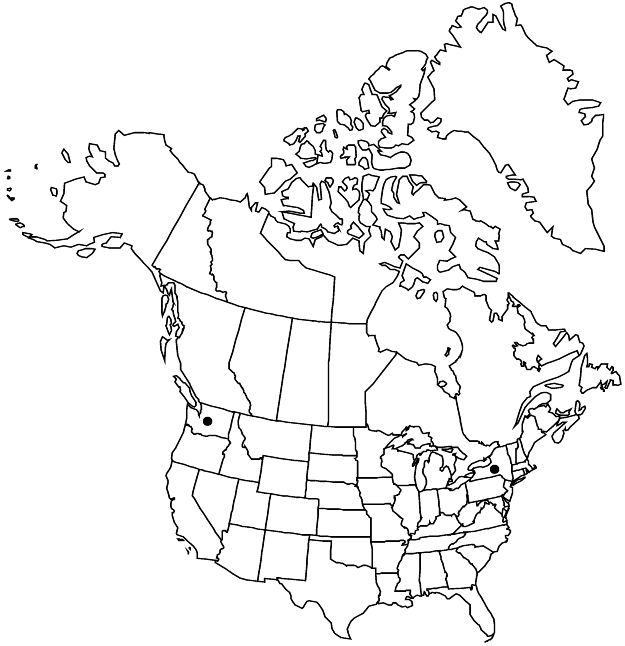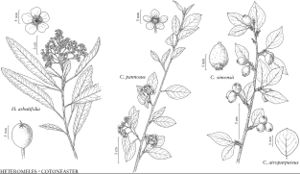Difference between revisions of "Cotoneaster atropurpureus"
Watsonia 18: 311. 1991.
FNA>Volume Importer |
FNA>Volume Importer |
||
| Line 31: | Line 31: | ||
|elevation=0–400 m | |elevation=0–400 m | ||
|distribution=N.Y.;Wash.;Asia (China);introduced also in Europe. | |distribution=N.Y.;Wash.;Asia (China);introduced also in Europe. | ||
| − | |discussion=<p>Although treated as synonymous with Cotoneaster horizontalis by L. Lingdi and A. R. Brach (2003), C. atropurpureus is separated by having somewhat thinner leaves on vigorous shoots that tend to be obovate instead of broadly elliptic, with obtuse to truncate apices and sometimes slightly wavy margins. It also tends towards less regular branching and somewhat darker petals and filaments.</p> | + | |discussion=<p>Although treated as synonymous with <i>Cotoneaster horizontalis</i> by L. Lingdi and A. R. Brach (2003), <i>C. atropurpureus</i> is separated by having somewhat thinner leaves on vigorous shoots that tend to be obovate instead of broadly elliptic, with obtuse to truncate apices and sometimes slightly wavy margins. It also tends towards less regular branching and somewhat darker petals and filaments.</p> |
|tables= | |tables= | ||
|references= | |references= | ||
| Line 56: | Line 56: | ||
|publication year=1991 | |publication year=1991 | ||
|special status=Selected by author to be illustrated;Introduced | |special status=Selected by author to be illustrated;Introduced | ||
| − | |source xml=https://jpend@bitbucket.org/aafc-mbb/fna-data-curation.git/src/ | + | |source xml=https://jpend@bitbucket.org/aafc-mbb/fna-data-curation.git/src/8f726806613d60c220dc4493de13607dd3150896/coarse_grained_fna_xml/V9/V9_775.xml |
|subfamily=Rosaceae subfam. Amygdaloideae | |subfamily=Rosaceae subfam. Amygdaloideae | ||
|tribe=Rosaceae tribe Gillenieae | |tribe=Rosaceae tribe Gillenieae | ||
Revision as of 18:19, 18 September 2019
Shrubs, 0.5–1 m. Stems ascending to erect, spreading horizontally, arching; branches divaricate, sometimes distichous, red-purple, initially densely yellowish strigose-villous. Leaves deciduous; petiole 1–2 mm, yellow-villous; blade elliptic, on vigorous shoots obovate-orbiculate, 9–14 × 8–12 mm, chartaceous, base obtuse or acute, margins flat or slightly undulate, veins 2 or 3, superficial or slightly sunken, apex obtuse or truncate, mucronulate, abaxial surfaces shiny, sparsely golden yellow-pilose, adaxial green to dark green, shiny, not glaucous, flat or scarcely bulging between lateral veins, glabrous; fall leaves ruby red. Inflorescences on fertile shoots 9–11 mm with 3 leaves, (1 or)2 or 3-flowered, compact. Pedicels 0.2–1 mm, pilose. Flowers 6 mm, closed or nearly so; hypanthium funnelform, sparsely yellow-pilose-strigose; sepals: margins yellow-villous, apex green and red-purple, acuminate or acute, surfaces sparsely pilose; petals erect-incurved, dark red, base purple-black, margins narrowly white; stamens 10–14, filaments dark red to dark purple-red, white distally, anthers white [pink-tinged]; styles 2 or 3(or 4). Pomes bright red, usually broadly obovoid, sometimes obovoid, 7–8 × 7–8 mm, shiny, not glaucous, glabrate; sepals suberect, margins villous, sparsely pilose; navel open; style remnants 3/4 from base. Pyrenes 2 or 3(or 4).
Phenology: Flowering May; fruiting Sep–Jan.
Habitat: Thickets, rock roadcuts, paths, edges of disturbed forests
Elevation: 0–400 m
Distribution

N.Y., Wash., Asia (China), introduced also in Europe.
Discussion
Although treated as synonymous with Cotoneaster horizontalis by L. Lingdi and A. R. Brach (2003), C. atropurpureus is separated by having somewhat thinner leaves on vigorous shoots that tend to be obovate instead of broadly elliptic, with obtuse to truncate apices and sometimes slightly wavy margins. It also tends towards less regular branching and somewhat darker petals and filaments.
Selected References
None.
